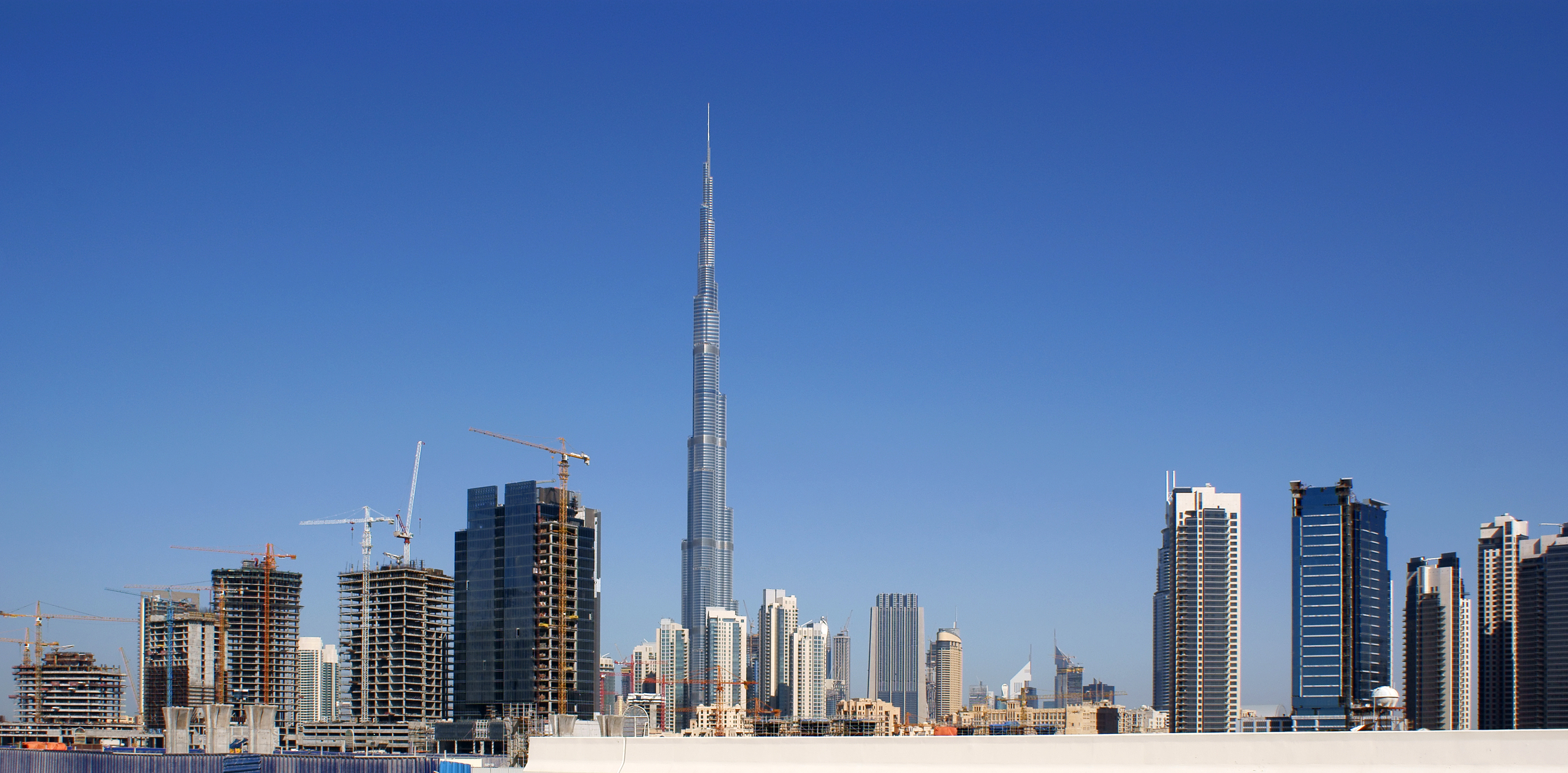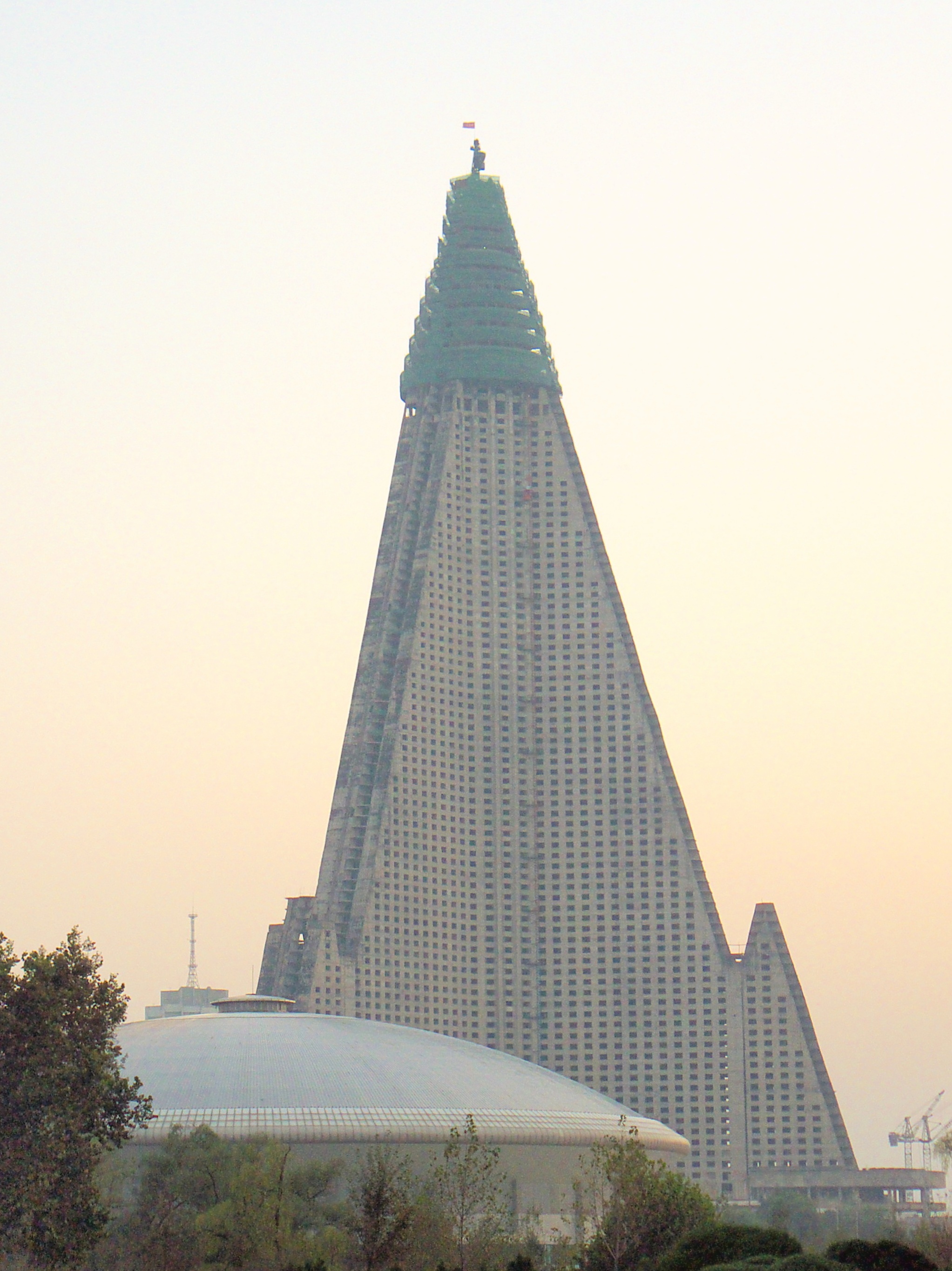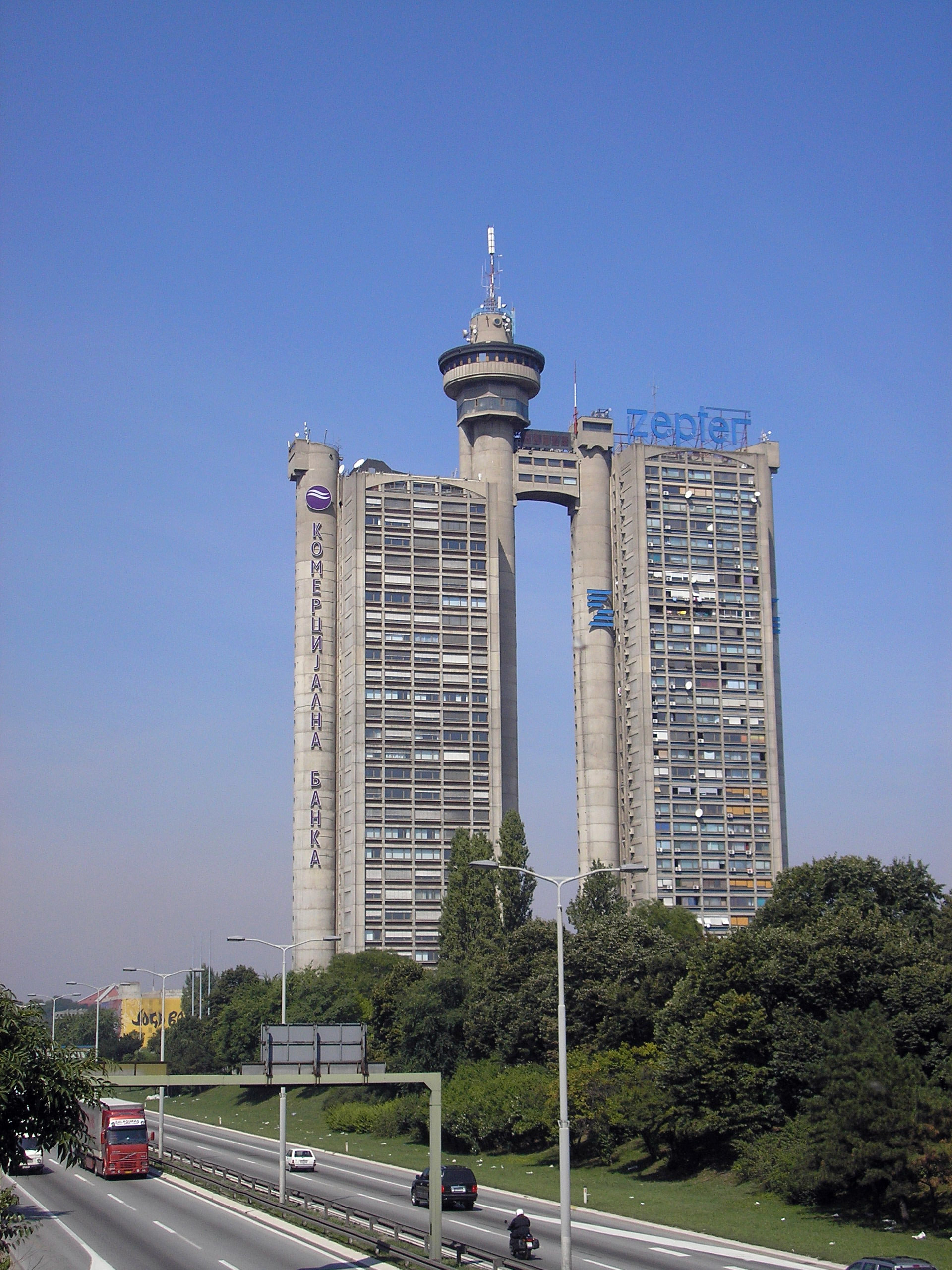The world today has its fair share of record-breaking tall buildings. Every several years, another one somewhere on the planet goes up and sets the new standard. But as humanity strives to go higher and higher, we can’t forget those buildings that today don’t seem that tall when compared to what else is out there, but which utterly dominate the urban landscape they’re in. Some cities around the world, though not especially known for their skyscrapers, if any at all, have buildings that stand alone, towering over everything else that surrounds them. We’ll be discussing 10 such buildings in this list below.
10. Burj Khalifa – UAE

In order to get the obvious out of the way first, we’ve decided to start off this list with the tallest: the Burj Khalifa in Dubai. While this city, and entire region for that matter, doesn’t lack its share of skyscrapers, the Burj Khalifa, standing at 2,716.5 feet, towers over the rest, as if they were mere hovels. This is the largest building currently in existence and there is no place within the city of Dubai where you can’t see it. Construction began in 2004 and the tower opened six years later.
Besides holding the record for the tallest building on Earth, it can also call itself the “tallest free-standing structure in the world”, with the highest number of stories and highest occupied floor. It also has the highest standing outdoor observation deck and an elevator with the longest travel distance. It’s so tall that those living at the top have to do their prayers two minutes after those on the ground, since the sun still shines up there, after the rest of Dubai falls into darkness.
In 2010 it received the “Best Tall Building Middle East & Africa” award by the Council on Tall Buildings and Urban Habitat Organization (which is apparently an actual award?), as well as many other titles and awards. Though there are plans to build an even larger (7,874 feet tall) building called Dubai City Tower, three times the height of Burj Khalifa, it will be a while until that will become a reality, if it ever does.
9. Sagrada Família Basílica – Barcelona, Spain

The second tallest building in Barcelona, The Basílica i Temple Expiatori de la Sagrada Família is only surpassed by Torre de Collserola, a communications tower, perched high up on a hill on the outskirts of the city. Nevertheless, down in the city center, no other building challenges this mighty church. Standing as high as 557 feet off the ground, its work began back in 1882 and was designed under Antoni Gaudi, who took over the project one year later.
He dedicated the last part of his life to it, dying in 1926 at age 73, when less than a quarter of the church had been built. Some 90 years later and still not finished, its progress can be called slow at best. The reason for this is the fact that its construction draws its funds only from private donations and was even interrupted during the Spanish Civil War in the late 1930s, only to resume intermittent construction in the 1950s.
Combining Gothic and Art Nouveau styles, Sagrada Família is a UNESCO World Heritage Site, and in November 2010, Pope Benedict XVI consecrated and proclaimed it a minor basilica. Describing it, art critic Rainer Zerbst said, “It is probably impossible to find a church building anything like it in the entire history of art,” and Paul Goldberger called it, “The most extraordinary personal interpretation of Gothic architecture since the Middle Ages.” George Orwell, on the other hand, called it “One of the most hideous buildings in the world.“ Whatever the case may be, construction reached its midpoint in 2010, with its completion being anticipated in 2026, 100 years after Gaudi’s death.
8. Ryugyong Hotel – Pyongyang, North Korea

The Ryugyong Hotel is a 105-story, pyramid-shaped skyscraper, located in Pyongyang, North Korea’s capital. Its name, “Ryugyong,” translates to “capital of willows” – which is also one of Pyongyang’s historical names. Still unfinished, its construction began back in 1987, during North Korea’s height. But it was halted in 1992 when the country went through a severe economic recession after the Soviet Union’s collapse. It was estimated to cost somewhere around $750 million to build, or two percent of the entire North Korean GDP.
Even if it was topped out when work on it was stopped, it still had no exterior windows or interior fittings. North Korean officials were embarrassed by the project and had all the official photographs of the city edited, so as to not show the massive concrete monolith. The hotel was removed from all printed maps of Pyongyang and became known as the “Hotel of Doom” or “Phantom Hotel.” The Korean government went so far as to even deny the hotel’s very existence for over a decade.
In 2008, however, construction on it resumed, and the exterior was completed three years later. Plans were to open the hotel in 2012, thus celebrating the centenary of Kim Jong-un’s grandfather, Kim Il-sung, but it didn’t happen. Its original opening date was set in 1989, in time for the 13th World Festival of Youth and Students. Had this been achieved, Ryugyong would have been the tallest hotel in the world at the time. Nevertheless, at 1,080 feet, it still stands today as the tallest building in Pyongyang, and the rest of North Korea itself.
7. Taipei 101 – Taipei, Taiwan

Located in the capital city of Taiwan, Taipei, this tower was officially classified as the tallest building in the world in 2004, only being surpassed in 2009 by the Burj Khalifa. Towering at 1,667 feet, it’s by far the tallest building around. Designs for both the interior and exterior of the tower are rich in Chinese culture. It incorporates the traditional Chinese pagoda architectural design, within the shape of bamboo flowers. The total cost for its construction was estimated to be somewhere around $1.6 billion and has a LEED – EBOM Platinum Certification, making Taipei 101 the world’s tallest Green Building.
It also houses the fastest elevators in the world, with a top speed of 55 feet per second, and a total of 61 such elevators. Its outside blue-green glass offers UV light protection for those inside and the Tower’s lights display one of seven colors in the light spectrum from 6:00 p.m. to 10:00 p.m. each evening. In order to protect it from any eventual typhoons or earthquakes, Taipei 101 is fitted with one of the largest damper systems in the world. Located at the 88th floor, an 800 metric ton spherical ball acts as a counterweight anytime the huge tower swings or shakes, thus offering it a great deal of stabilization.
6. The Palace of Parliament – Bucharest, Romania
During the height of the Communist regime in Romania, the capital city of Bucharest was hit by a tremendous earthquake in 1977. Many buildings were severely damaged as a result, and the president at that time, Nicolae Ceausescu, took advantage of the situation. He proposed a plan to consolidate the city and rebuild it with a more “modern” design. While Bucharest was boasting its own unique architectural design, a fifth of the old city center was razed to the ground to make room for grand boulevards, tall apartment buildings, and a huge structure worthy of the dictator’s megalomania.
By no means the tallest in the world, the Palace of Parliament still dominates its immediate surroundings. Perched on a hill, the structure towers some 282 feet into the air, and goes another 301 feet underground. With a total of 1,100 rooms it covers a surface area of 3.7 million square feet, making it the second largest building in the world, after the Pentagon. And according to Guinness World Records, it’s the heaviest building in the world. It’s made out of 700,000 metric tons of steel and bronze, a million square feet of marble, 3,500 metric tons of crystal, and 900,000 square meters of wood. Its inside is luxurious, to say the least. In the 1990s, Donald Trump proposed to transform it into the largest casino in the world.
It now houses the Romanian Parliament, which occupies a mere 30% of its space. Its construction began in the early 1980s but wasn’t finished by the time the Communist regime was toppled in 1989. No further additions have been brought to it, and the decision was made to leave it as is. It has an energy consumption equivalent to a city of 250,000 inhabitants.
5. Eiffel Tower – Paris, France

When the Nazis took over Paris, Hitler came by to gloat in his triumph over the French and parade throughout the city. But in the night before his arrival, the French Resistance cut the elevator cables of this famous landmark, forcing Hitler to climb the 1,665 stairs, which he never did. While he did manage to conquer Paris, he never did conquer the Eiffel Tower. In 1944, when it became evident that the Allies would retake the city, Hitler ordered General Dietrich von Choltitz, the military governor of Paris, to turn the city into rubble, including the tower itself. The General never did carry out the command, and shortly after Paris was retaken the Tower’s lifts began working again.
Standing at 984 feet tall (1,063 when including the antenna at the top), the Eiffel Tower was the largest manmade structure in the world for 41 years from 1889 to 1930, when the Chrysler Building in New York was finished. It’s still the tallest in Paris. Though it was built for an exposition, it was never intended to be permanent and was scheduled to be demolished in 1909. However, it was spared this fate after being repurposed as a giant radio antenna. It was also originally intended to be built in Barcelona, but obviously that never happened.
It’s made out of 18,000 individual metallic parts, joined together by 2.5 million rivets, and its height varies by up to six inches depending on the outside temperature. At the moment it’s the most visited paid-for monument in the world, with roughly seven million visitors each year. And as a result, the lifts that Hitler couldn’t use back in 1940 travel on average a distance of 64,000 miles; two and a half times the circumference of the Earth. What most of us don’t know is that in 2008, the tower got “married” to a woman by the name of Erika La Tour Eiffel, whose name is in honor of her “partner.”
4. Lotte World Tower – Seoul, South Korea

Though not yet finished, the Lotte World Tower in Seoul, South Korea was topped out in December 2015, with the completion of its 123rd floor. Towering at 1,820 feet, it is the tallest building in South Korea and in fact, the entire OCDE. It’s expected to be finished in October 2016. The uppermost part, floors 120 to 123 of Lotte World Tower, will serve as an observatory. Floors 117 to 119 will be home to an art gallery. A hotel, offices, a medical center, and other amenities are also expected to open.
On March 27, 2016, there was a break-in reported at the tower. While fearing North Korean infiltration, the authorities were alerted about this intrusion. That turned out to not be the case, however. Two photographers, Vitaly Raskalov and Vadim Makhorov from Ukraine and Russia, respectively, climbed to the top in order to take pictures and a video. The duo is renowned throughout the world in the exploration of high-rise architectural structures like skyscrapers, bridges, historic sites, and cathedrals.
3. The Eastern Gates of Belgrade – Serbia

While Serbia’s capital city of Belgrade is renowned for its many gates were built throughout the centuries, offering its citizens both access and protection, the latest two additions had a somewhat different purpose. Built during the late 1970s and early 1980s by the Yugoslavian Communist regime, the Western Gate, more commonly known as the Genex Tower, is 35 stories (460 feet) tall. One part serves as an apartment block, while the other is an office building for the Genex Group. The building was designed to greet and amaze people coming in from the west, as the road connects Belgrade to its airport. But while this tower was especially designed as a gateway, per se, its Eastern counterpart was not.
The Eastern Gates of Belgrade are in fact a series of three identical, gigantic apartment blocks. They’re officially known as the Rudo Apartment Complex, after a town in Bosnia. This complex utterly overshadows the surrounding urban landscape of Belgrade, and is made to house more than 2,000 people. Made in a Socialist Realist architectural style, more commonly known as brutalist architecture, the three towers each stand at 325 feet tall. As if from an Orwellian dystopian future, they do look like something out of Blade Runner. Compared to their sister building at the other side of town, these three giant monoliths were dubbed as “the Eastern Gates of Belgrade.”
2. Tokyo Skytree – Tokyo, Japan

In 2011, upon reaching an astounding height of 2,080 feet, Tokyo Skytree became the tallest building in Japan, the tallest tower in the world, and the second tallest structure ever made after Burj Khalifa. It acts as the primary television and radio broadcast site in Tokyo, since the old tower was slowly surrounded by tall buildings and its signal power decreased over time. Completed in 2012, the base has a structure similar to a tripod. From about 1,150 feet upward, the tower’s structure is cylindrical, offering to those inside a beautiful panoramic view of the river and city. It has two observatories, located at 1,150 feet and 1,480 feet, with the top one featuring a glass floor for its visitors to look straight down at the streets below.
Typical to the Japanese, the Tokyo Skytree is equipped with state of the art security systems, specifically tailored for the country’s frequent earthquakes. Its name was selected from a total number of six candidates, and was put to a national vote. The name “Tokyo Skytree” won by a majority of 30%, with the second most popular name being “Tokyo Edo Tower.” Its exterior is painted in a unique color called “Skytree White.” This is based on the traditional Japanese bluish-white color called aijiro, and helps the tower blend in harmoniously with its surroundings. After dark, the tower is illuminated in two different patterns, alternating daily. A sky-blue one, called Iki (chic, stylish), and a purple one called Miyabi (elegance, refinement).
1. Abraj Al Bait – Mecca, Saudi Arabia

Also known as the Makkah Royal Clock Tower Hotel, this humongous building is government-owned and located in the holiest place within the Muslim world: Mecca, Saudi Arabia. With a height of 1,972 feet, it is the fourth tallest freestanding structure in the world. It holds the largest clock on Earth, and the structure itself is visible from up to 16 miles away. Some 21,000 white and green colored lights, the same as the Saudi Flag and fitted at the top of the clock, flash to signal Islam’s five-times daily prayers, and are visible as far as 19 miles away.
Abraj Al Bait’s construction began back in 2004 and was completed in 2012, offering 1,542 guest rooms and residences for around 10,000 pilgrims arriving in the city during the annual Hajj ceremony. It is conveniently located just across the street from the Masjid al Haram mosque, and has countless other facilities throughout its immense structure. The entire complex was built after the demolition of the Ajyad Fortress, an 18th century Ottoman citadel overlooking the Grand Mosque. The destruction of the fort in 2002 by the Saudi government sparked Turkish, international, and even domestic outcry.
2 Comments
Who else? <3
I didn’t realize height and bulk were the only criteria.